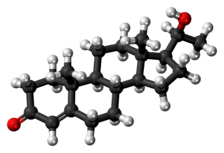20α-Dihydroprogesterone
 | |
 | |
| Names | |
|---|---|
| IUPAC name
(8S,9S,10R,13S,14S,17S)-17-[(1S)-1-hydroxyethyl]-10,13-dimethyl-1,2,6,7,8,9,11,12,14,15,16,17-dodecahydrocyclopenta[a]phenanthren-3-one | |
| Other names
20α-DHP; 20α-Hydroxyprogesterone; 20α-OHP; 20α-Hydroxypregn-4-en-3-one; Pregn-4-en-20α-ol-3-one | |
| Identifiers | |
| |
3D model (JSmol) |
|
| ChemSpider | |
| ECHA InfoCard | 100.005.136 |
| EC Number | 205-649-5 |
| MeSH | 20-alpha-Dihydroprogesterone |
PubChem CID |
|
| UNII | |
| |
| |
| Properties | |
| C21H32O2 | |
| Molar mass | 316.478 g/mol |
Except where otherwise noted, data are given for materials in their standard state (at 25 °C [77 °F], 100 kPa). | |
| Infobox references | |
20α-Dihydroprogesterone (20α-DHP), also known as 20α-hydroxyprogesterone (20α-OHP), is a naturally occurring, endogenous progestogen.[1][2][3] It is a metabolite of progesterone, converted by the 20α-hydroxysteroid dehydrogenases AKR1C1 and AKR1C3, and is still active as a progestogen.[4] However, it is much less potent in comparison, with about one-fifth of the progestogenic activity of progesterone.[1][2][3][5] It has been found to act as an aromatase inhibitor and to inhibit the production of estrogen in breast tissue in vitro.[6]
See also
References
- 1 2 Beranič N, Gobec S, Rižner TL (2011). "Progestins as inhibitors of the human 20-ketosteroid reductases, AKR1C1 and AKR1C3". Chem. Biol. Interact. 191 (1–3): 227–33. doi:10.1016/j.cbi.2010.12.012. PMID 21182831.
- 1 2 Tony M. Plant; Anthony J. Zeleznik (15 November 2014). Knobil and Neill's Physiology of Reproduction: Two-Volume Set. Academic Press. pp. 1–. ISBN 978-0-12-397769-4.
- 1 2 Cynthia L. Darlington (27 April 2009). The Female Brain. CRC Press. pp. 4–. ISBN 978-1-4200-7745-2.
- ↑ Marianne J. Legato (29 October 2009). Principles of Gender-Specific Medicine. Academic Press. pp. 617–. ISBN 978-0-08-092150-1.
- ↑ Bertram G. Katzung (30 November 2017). Basic and Clinical Pharmacology 14th Edition. McGraw-Hill Education. p. 728. ISBN 978-1-259-64116-9.
In addition to progesterone, 20α- and 20β-hydroxyprogesterone (20α- and 20β-hydroxy-4-pregnene-3-one) also are found. These compounds have about one-fifth the progestational activity of progesterone in humans and other species.
- ↑ Pasqualini JR, Chetrite G (2008). "The anti-aromatase effect of progesterone and of its natural metabolites 20alpha- and 5alpha-dihydroprogesterone in the MCF-7aro breast cancer cell line". Anticancer Res. 28 (4B): 2129–33. PMID 18751385.
This article is issued from
Wikipedia.
The text is licensed under Creative Commons - Attribution - Sharealike.
Additional terms may apply for the media files.